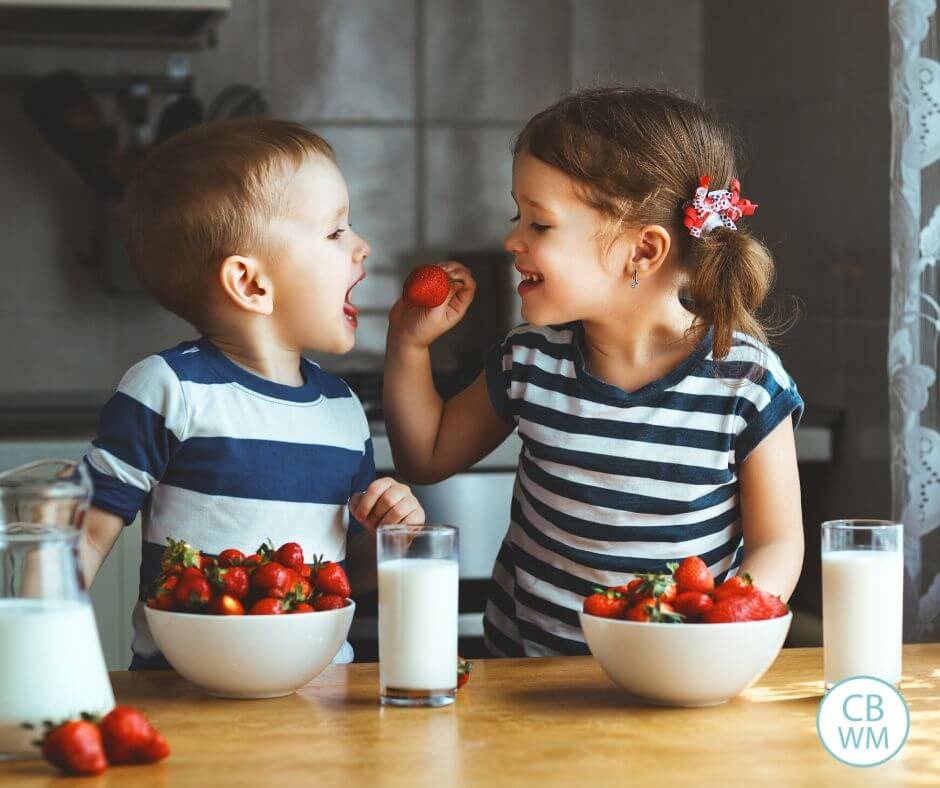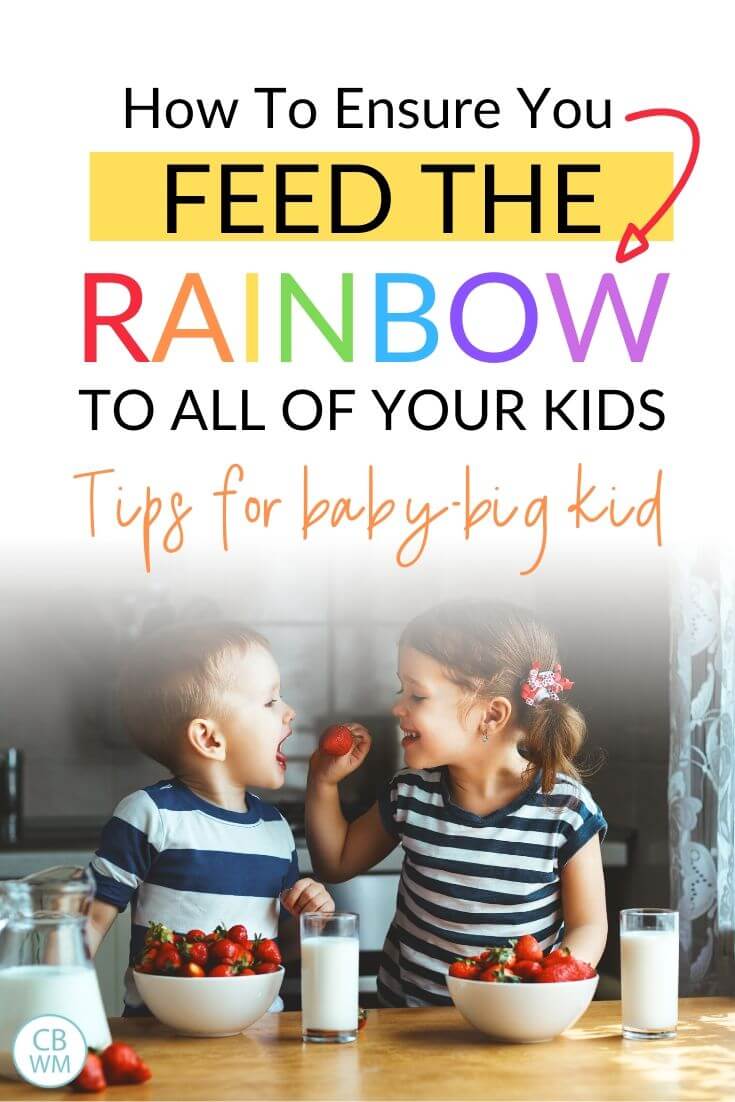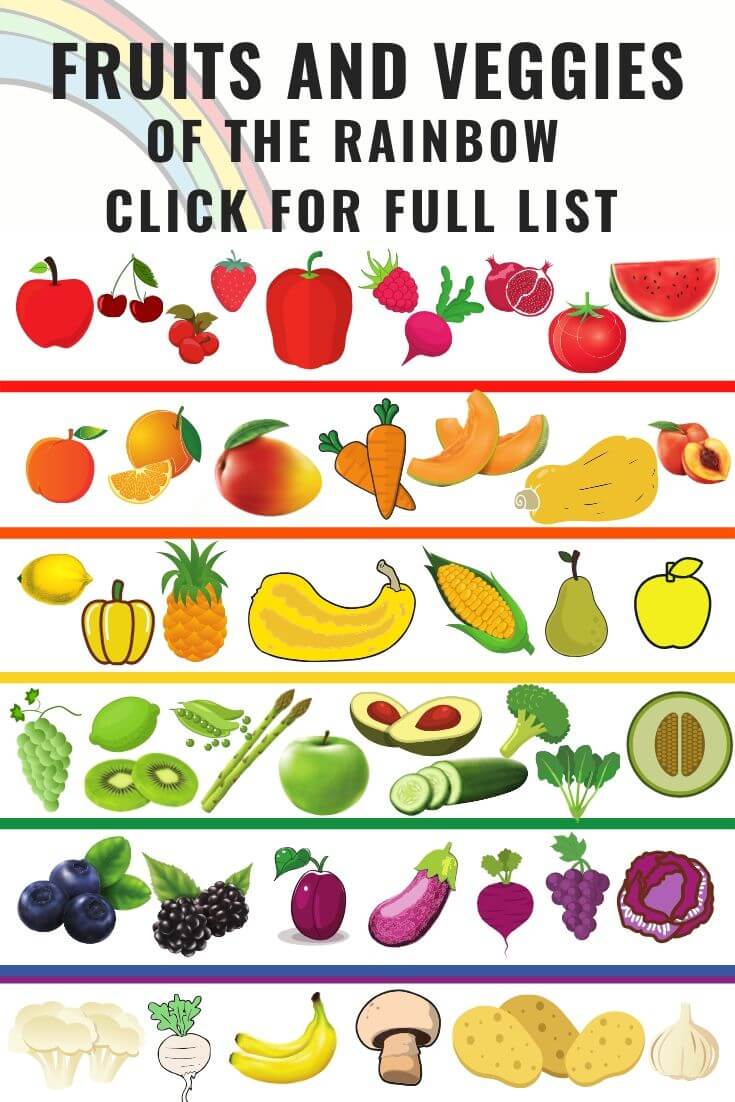When you “feed the rainbow” then you are feeding your kids a healthy diet of a variety of foods. Get a list of which fruits and veggies are in each color category.
In order to have a varied and healthy diet, it is wise to eat all the colors of the rainbow when it comes to fruits and vegetables. Different colored produce contains different nutrients. When you eat a variety, you get a variety of vitamins, minerals, and phytonutrients (stuff like beta-carotene).
I have often heard this over the years. This is the reason I feed my babies a green veggie at lunch every day and a yellow veggie at dinner. That way I make sure green and yellow are covered each day. I then apply a color of fruit to each meal.
There have been some things I have often wondered about. Take apples. The skin is red (or green), but the flesh is yellow/white. So what color am I eating? (the answer is red–if the apple is red).
I have compiled a list of the colors of the rainbow and the fruits and veggies you, your spouse, your children, and your baby can eat.
NOTE: not all of the foods listed below are safe for babies. Please be sure to feed only age-appropriate foods to infants and toddlers.
Post Contents
RED FOODS
Many red foods may help reduce the risk of some cancers. Many red foods also contain antioxidants that help prevent cell damage and help keep your heart healthy.
Fruits
- Apples (red apples).
- Cherries
- Strawberries
- Red grapes
- Cranberries
- Pink grapefruit
- Pomegranates
- Raspberries
- Watermelon
Vegetables
- Beets
- Red cabbage
- Red peppers
- Red potatoes (I didn’t know this!)
- Radishes
- Rhubarb (it is a vegetable. Look it up)
- Tomatoes (I know it is can be debated about fruit or vegetable. And a side note, it is the state vegetable of New Jersey and the state fruit of Ohio. Also, I read that the benefits of tomatoes are better when they are cooked and served with some fat, like in spaghetti sauce).
ORANGE & YELLOW FOODS
Orange produce contains vitamin A, which is good for your eyes. Orange produce can reduce the risk of cancer and heart disease. It is also supposed to boost the immune system. But take note that citrus foods like oranges are not a good source of vitamin A, though they do provide vitamin C folate and a B vitamin.
Fruits
- Peaches
- Apricots
- Nectarines
- Yellow apples
- Cantaloupe
- Grapefruit
- Lemons
- Oranges
- Tangerines
- Mangoes
- Papayas
- Pineapples
- Yellow watermelon
- Pears (although I have also read they are white, not orange/yellow)
Vegetables
- Carrots
- Squash (butternut, winter, yellow summer)
- Pumpkins
- Sweet Potatoes
- Corn
- Yellow peppers
- Rutabagas
- Yellow tomatoes
GREEN FOODS
Some green foods help to reduce the risk of cataracts and age-related macular degeneration in the eyes. Others help protect against cancer. Others contain folate, which reduces the risk of birth defects.
Fruits
- Green apples
- Avocado
- Green grapes
- Honeydew
- Kiwi
- Limes
Vegetables
- Artichokes
- Asparagus
- Green beans
- Broccoli
- Brussels sprouts
- Green cabbage
- Cucumbers (another controversial one. I use the same reasoning to have it as veggie as I do tomatoes).
- Lettuce
- Spinach
- Green onions
- Peas
- Green peppers
- Zucchini
BLUE & PURPLE FOODS
These foods contain antioxidants that protect cells from damage. They may reduce the risk of cancer, stroke, and heart disease.
Fruits
- Blackberries
- Blueberries
- Prunes
- Plums
- Figs
- Juneberries
- Raisins
- Purple grapes
Vegetables
- Eggplant (technically a fruit, but used as a veggie, so I list it here)
WHITE FOODS
These white foods may help lower blood pressure. They also may help reduce the risk of stomach cancer and heart disease. Some are also a good source of potassium.
Fruits
- Bananas
- Pears (yellow or white? I have read both)
- Ginger
Vegetables
- Cauliflower
- Garlic
- Mushrooms (I know it is a fungus, but it fits best with veggies)
- Potatoes
- Turnips
- Parsnips
There you have it. There are more out there, especially in different countries. This list is by no means all-inclusive.
More more extensive information on what each food does for the body, see the book Super Baby Food.



